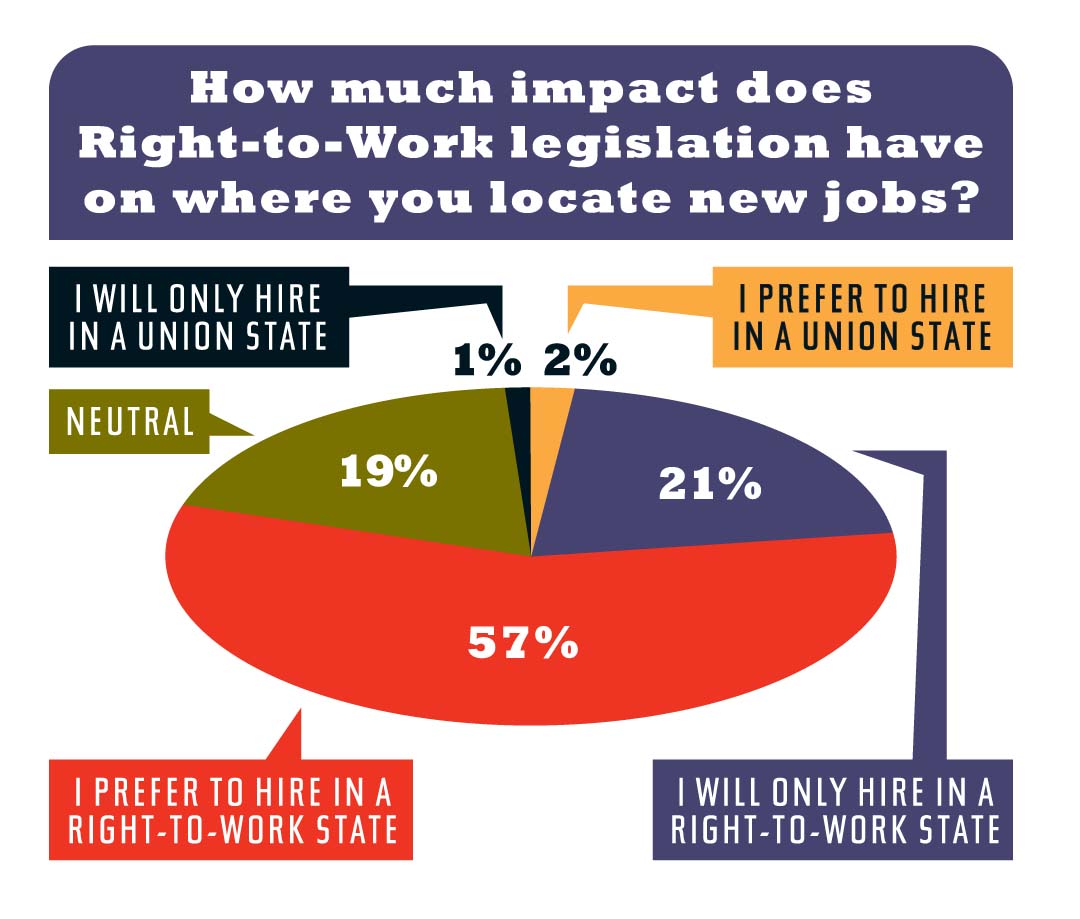
For the 13th year in a row, CEOs weigh in on what each of the 50 states has to offer your business.
While there is a level of constancy when it comes to the very best and very worst states for business as ranked by CEOs, there is plenty of jockeying for position within the ranks, and even some leaping and plummeting.
Because of how CEOs view business climates, because states themselves have varying priorities and because of the slow pace of change in many state governments, the same states have held top five spots for six years running.
The complete listing for the 2018 Best and Worst States for Business can be found here.
Texas was ranked No. 1 for the 13th straight year in 2017 by the hundreds of CEOs surveyed by Chief Executive. Florida was No. 2 for the fifth year in a row. Five of the remaining eight top-10 states were the same as in 2011, albeit shuffled a bit. On the other end of the spectrum, California anchored the bottom of the list at No. 50 for the sixth consecutive year, New York wallowed at No. 49 and Illinois listed at No. 48.
 Yet this consistency at the top and bottom ranks occurred at the same time as dynamic movement by those in the middle 30: Ohio leaped to No. 11 from No. 22 just two years ago and No. 41 in 2011, for instance, and Louisiana slid to No. 33 this year from No. 7 just two years ago. Others, such as Wisconsin, have gradually edged upward. (Gov. Scott
Yet this consistency at the top and bottom ranks occurred at the same time as dynamic movement by those in the middle 30: Ohio leaped to No. 11 from No. 22 just two years ago and No. 41 in 2011, for instance, and Louisiana slid to No. 33 this year from No. 7 just two years ago. Others, such as Wisconsin, have gradually edged upward. (Gov. Scott
Walker explains the Badger State’s rise at ChiefExecutive.net/2017-BWStates.)
Nonetheless, the very best and very worst states have remained the same at a time of unprecedented attention by CEOs, governors, state economic development departments (EDCs) and others to the importance of landing new and expanded factories, offices and warehouses as America climbed out of the recession and competition for jobs became fierce.
One big reason for stasis in the rankings is that Chief Executive surveys CEOs, not corporate site-development specialists. Company leaders usually choose to focus on the big picture, so their perceptions often trump statistical minutiae.
 “CEOs don’t get involved in the numbers that much, and we seldom meet with them,” says Dean Uminski, a site-selection specialist with Crowe Horwath in Chicago. “But it’s their perceptions that really matter, because usually they end up making the ultimate decision.”
“CEOs don’t get involved in the numbers that much, and we seldom meet with them,” says Dean Uminski, a site-selection specialist with Crowe Horwath in Chicago. “But it’s their perceptions that really matter, because usually they end up making the ultimate decision.”
And, while perceptions can take a long time to change, reality may be even more resistant. “The top-ranking states have continued to implement public policy supporting economic development to ensure that they remain as leaders,” says Larry Gigerich, executive managing director of Ginovus, a Fishers, Indiana-based site-selection concern.
Meanwhile, adds Kathy Mussio, managing partner of Atlas Insight, a site-selection consultant based in Freehold, New Jersey, the bottom-dwelling states “have consistently
high tax burdens and onerous regulatory environments—so they’re not only perceived
as being business-unfriendly, they are. It’s reality.”
Change also takes time. “To abruptly change a state’s tax structure or labor laws is a two- to four-year event at a minimum, mainly because of electoral cycles,” notes King White, president of Site Selection Group in Dallas.
In addition to presenting CEOs’ views on how states rank, the pages to follow highlight some of the economic efforts and initiatives going on across country.
FLORIDA keeps ranking No. 2 in part because CEOs find it the No. 5 living environment. CEOs ranked its workforce quality a relatively low No. 18. And the state’s economic development efforts are in question due to infighting between Republican Gov. Rick Scott and the Republican-controlled legislature.
ILLINOIS is facing by far the biggest fiscal crisis of any state but remained atop New York and California. The politically divided Land of Lincoln suffers from huge public-worker pension costs, an $11 billion backlog of bills and a $13 billion budget deficit that could hit $20 billion in the next fiscal year.
NEW HAMPSHIRE seems to suffer more than any other state from simple negative perceptions by CEOs. In the survey, it’s ranked 31st overall even though the Granite State came up a shiny No. 1 in workforce quality, No. 4 in taxation and regulation and No. 19, its
lowest ranking, in living environment.
NORTH CAROLINA may face an estimated $4 billion in economic losses because of its decision on transgender bathrooms, including PayPal’s cancellation of a planned facility there. But CEOs kept the state at No. 3 this year, including No. 7 for living environment
and No. 6 for workforce quality. And since the Tar Heel State recently caved to pressure and rescinded the law in part because, as Gov. Roy Cooper said, “it caused great economic harm,” now it is poised for a comeback.

Chief Executive Group exists to improve the performance of U.S. CEOs, senior executives and public-company directors, helping you grow your companies, build your communities and strengthen society. Learn more at chiefexecutivegroup.com.
0

1:00 - 5:00 pm
Over 70% of Executives Surveyed Agree: Many Strategic Planning Efforts Lack Systematic Approach Tips for Enhancing Your Strategic Planning Process
Executives expressed frustration with their current strategic planning process. Issues include:
Steve Rutan and Denise Harrison have put together an afternoon workshop that will provide the tools you need to address these concerns. They have worked with hundreds of executives to develop a systematic approach that will enable your team to make better decisions during strategic planning. Steve and Denise will walk you through exercises for prioritizing your lists and steps that will reset and reinvigorate your process. This will be a hands-on workshop that will enable you to think about your business as you use the tools that are being presented. If you are ready for a Strategic Planning tune-up, select this workshop in your registration form. The additional fee of $695 will be added to your total.

2:00 - 5:00 pm
Female leaders face the same issues all leaders do, but they often face additional challenges too. In this peer session, we will facilitate a discussion of best practices and how to overcome common barriers to help women leaders be more effective within and outside their organizations.
Limited space available.

10:30 - 5:00 pm
General’s Retreat at Hermitage Golf Course
Sponsored by UBS
General’s Retreat, built in 1986 with architect Gary Roger Baird, has been voted the “Best Golf Course in Nashville” and is a “must play” when visiting the Nashville, Tennessee area. With the beautiful setting along the Cumberland River, golfers of all capabilities will thoroughly enjoy the golf, scenery and hospitality.
The golf outing fee includes transportation to and from the hotel, greens/cart fees, use of practice facilities, and boxed lunch. The bus will leave the hotel at 10:30 am for a noon shotgun start and return to the hotel after the cocktail reception following the completion of the round.